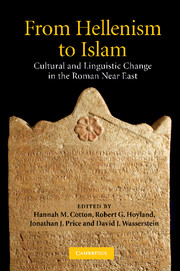Book contents
- Frontmatter
- Contents
- List of figures
- List of tables
- List of contributors
- Preface
- List of abbreviations
- Introduction: documentary evidence, social realities and the history of language
- Part I THE LANGUAGE OF POWER: LATIN IN THE ROMAN NEAR EAST
- Part II SOCIAL AND LEGAL INSTITUTIONS AS REFLECTED IN THE DOCUMENTARY EVIDENCE
- Part III THE EPIGRAPHIC LANGUAGE OF RELIGION
- Part IV LINGUISTIC METAMORPHOSES AND CONTINUITY OF CULTURES
- 10 On the margins of culture: the practice of transcription in the ancient world
- 11 Edessene Syriac inscriptions in late antique Syria
- 12 Samaritan writing and writings
- 13 The Jewish magical tradition from late antique Palestine to the Cairo Genizah
- Part V GREEK INTO ARABIC
- Index
11 - Edessene Syriac inscriptions in late antique Syria
Published online by Cambridge University Press: 01 March 2010
- Frontmatter
- Contents
- List of figures
- List of tables
- List of contributors
- Preface
- List of abbreviations
- Introduction: documentary evidence, social realities and the history of language
- Part I THE LANGUAGE OF POWER: LATIN IN THE ROMAN NEAR EAST
- Part II SOCIAL AND LEGAL INSTITUTIONS AS REFLECTED IN THE DOCUMENTARY EVIDENCE
- Part III THE EPIGRAPHIC LANGUAGE OF RELIGION
- Part IV LINGUISTIC METAMORPHOSES AND CONTINUITY OF CULTURES
- 10 On the margins of culture: the practice of transcription in the ancient world
- 11 Edessene Syriac inscriptions in late antique Syria
- 12 Samaritan writing and writings
- 13 The Jewish magical tradition from late antique Palestine to the Cairo Genizah
- Part V GREEK INTO ARABIC
- Index
Summary
The ‘Old Syriac’ inscriptions of the first three centuries CE (the earliest is dated to 6 CE) are best classified along with the other local Middle Aramaic dialects which made their epigraphic appearance, each with its own distinctive script, around the turn of the Common Era, namely Nabataean (first century BCE to mid-fourth century CE), Palmyrene (mid-first century BCE to late third century CE), and Hatran (mid-first century BCE to early third century CE). Th e number of known Old Syriac inscriptions is relatively small (c. 100) compared with the other Middle Aramaic dialects (Nabataean, c. 5,500; Palmyrene, c. 2,850; Hatran, c. 450). Since it was the local Aramaic dialect of Edessa (Syriac Orhay, modern (Şanli) Urfa), it is not surprising that most of the Old Syriac inscriptions come from Edessa or its vicinity, and all belong to Osrhoene (though the two earliest ones, dated 6 CE and 73 CE, are from Birecik, on the Euphrates, and Serrin, in the western part of Osrhoene). An isolated ostracon has turned up in Germany, but otherwise there is nothing comparable to the geographic spread of the Nabataean and, above all, the Palmyrene inscriptions, the latter spanning from South Shields (in northern England) to Soqotra.
The majority of the Old Syriac inscriptions belong to the second half of the second and first half of the third century, and quite a few are dated (see Appendix). They are to be found on stone and in mosaic, and in both categories many are funerary in character.
- Type
- Chapter
- Information
- From Hellenism to IslamCultural and Linguistic Change in the Roman Near East, pp. 289 - 302Publisher: Cambridge University PressPrint publication year: 2009
- 2
- Cited by



